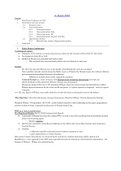11: Road to WW2
Content:
1. Paris Peace Conference in 1919
2. Interbellum (interwar period)
2.1. Economic crisis
2.2. Class polarisation
2.2.1. Communist threat
2.2.2. Class polarisation: Italy
2.2.3. Class polarisation: DL
2.2.4. Class polarisation: Spanish Civil War
2.3. Appeasement politics
2.3.1. Munich Crisis, climax of Appeasement politics
3. Conclusion
1. Paris Peace Conference
“A meeting of victors”
● Delegates of 27 nations, yet main decisions are taken by the Council of Four (UK, Fr, US, Italy)
● No delegation from DL or A-H.
● Bolshevik Russia was excluded and took no part.
○ Was isolated from international politics and not allowed to take part.
Context
- By 1919, the late ally Russia was in the hands of the Bolsheviks and was excluded.
- New republics already existed along the Baltic coast, in Poland, the Danube basis, but without effective
governments/acknowledged frontiers (boundaries).
- Difficult to include these newly organised countries.
- Central Europe in a state of chaos, with Russian-style revolution threatening to break out.
- Allied blockade of DL continued, Western Europe was devastated.
- Europeans looked with awe to US president Wilson; American intervention had decided the conflict;
Wilson enjoyed eminence for his views on IR and peace. (14 points speech to congress) - seen as a great
visionary.
==> US, esp. figure of Wilson, was really looked at to take the lead in setting the tone for the debate.
“The Big Four”: David Loyld George, George Clemenceau, Woodrow Wilson, Vittorio Emanuele Orlando.
Woodrow Wilson - US president 1913-1921- really looked towards to take leadership in the peace propositions
and the outline of what a peaceful architecture of Europe looked like.
WWI as a “war to end all wars”
The Fourteen Points: Jan 8, 1918 Congressional Speech
● A proposal outlining his vision for ending WW1 in such a way that would prevent devastating warfare
from ever occurring again.
○ Realise stability.
● Speech also intended to keep Russia fighting on the Allied side, boost Allied morale and undermine
Central Powers.
● Content
○ ½ addresses specific territorial issues between countries at war.
○ ½ gave expression to a vision of peace.
After peace treaties discussions, he returned home and had to confront American public opinion and
Republicans. - were opposed to the TOV and especially the idea of creating an international organization - the
League of Nations - Wilson was advocating for.
, 14 points:
1) Transparency in IR
Wanted them to be guided by “open covenants (agreements) to be openly arrived at”: a plea to end secret treaties
and secret diplomacy.
2) A peace without victory:
- A peace proposal favoring the repair of diplomatic relations and stability, as opposed to the punishment
of Central Powers.
- Analogy to the Congress of Vienna (1815)
- A victory would apply a dichotomy between victors and losers, who’d potentially seek retaliation for the
punishment.
3) A liberal, free world
- Removal of trade barriers and inequalities in international trade.
- Freedom of seas alike in times peace and war.
- Reduction of armaments of all powers.
4) National self-determination
- = principle that groups bound by common language/lines of descent have a right to territorial
independence.
- Belong to each other, constitute a nation & should => have the right to sovereignty over their
own territory and be allowed to govern themselves.
Pleaded for:
- Evacuation of occupied territories, self-determination for nationalities and redrawing of European
boundaries along national lines.
- Colonial readjustments: giving equal weight to people in colonised countries and colonists.
The issue regarding colonialism was more difficult: after the Conference, the US, nor the resulting peace
treaties, did not suddenly abolish imperial empires.
Also unclear whether Wilson was actually in favor of this.
Many of the colonised countries looked towards the US as a non-imperialist force that would be able to free the
world and spread democracy.
In contradiction, big Euorpean powers had by then developed big imperial empires across the globe.
But: Wilson remained rather modest on any liberationist aspirations and said nothing more than giving equal
weight.
Not much changed in terms of empires after the peace treaties; - lots of disappointment from the colonised
towards (esp) the US.
Many saw it as a betrayal of national self-determination that would be the guiding principle in the Paris Peace
Conference.
5) An international political organisation to prevent war
- A League of Nations (1920): a general association of nations to guarantee the independence and
territorial integrity of member countries.
Use 2 main instruments:
- Multilateralism & conflict resolution:
- A permanent international body in which countries would meet and settle conflicts without
sacrificing sovereign rights over their territory.
- Multilateralism: open, non-secretive relationships and diplomatic engagements between
countries.




